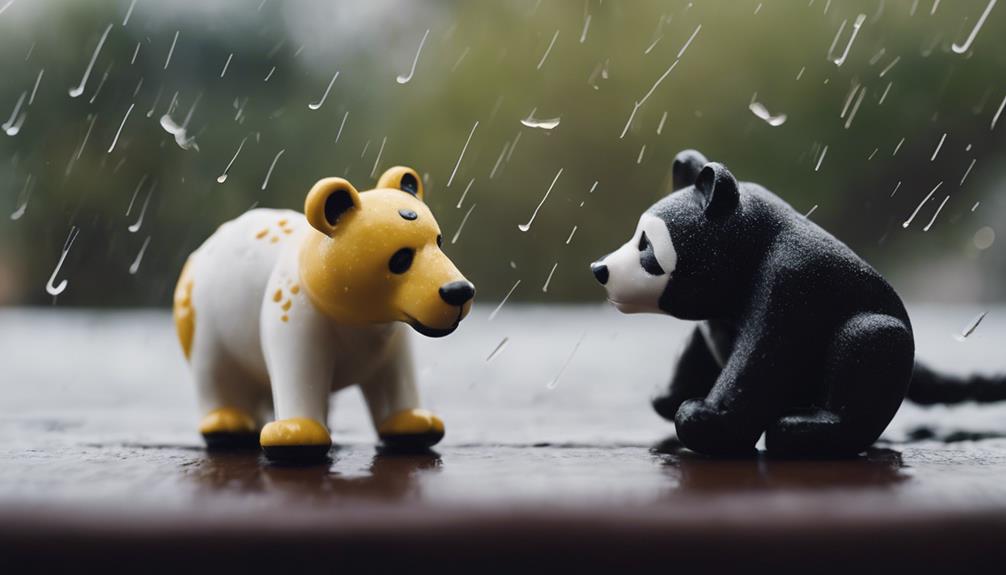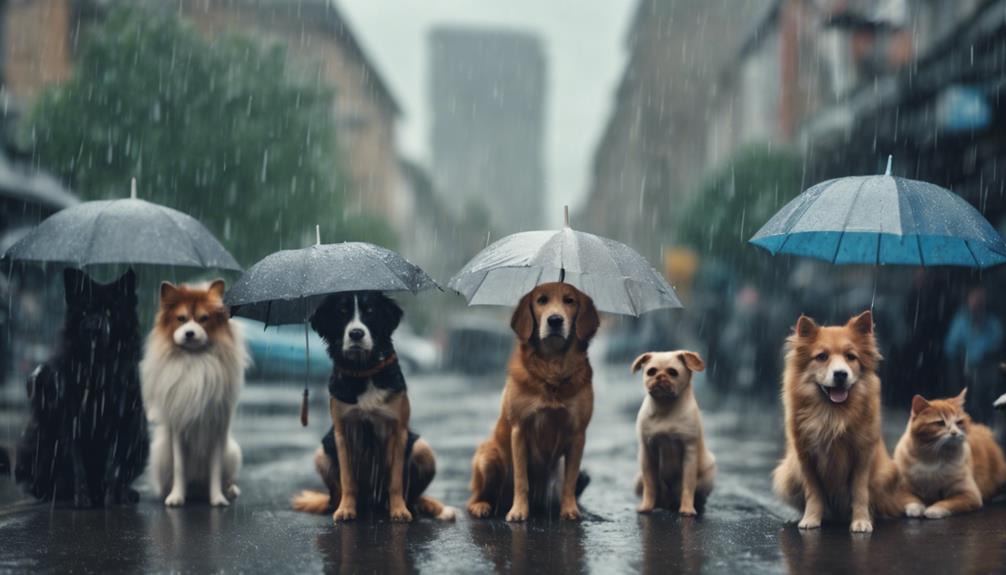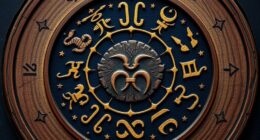Decoding the idiom 'Raining Cats and Dogs' reveals a rich history rooted in Norse mythology, literary works, and Jonathan Swift's influence. Originating in Henry Vaughan's 1651 poems and later popularized by Swift in 1738, the phrase symbolizes intense rainfall through vivid imagery. In Norse mythology, Odin's dogs represented storms, linking to weather folklore. Swift's satire added humor and satire to the idiom, cementing its place in modern language. Cultural adaptations across languages demonstrate how expressions evolve and intertwine with different societies. Exploring these depths offers insight into the interconnectedness of language and culture. Dig deeper for a nuanced understanding.
Key Takeaways
- Originated in Norse mythology and Greek culture.
- Popularized by Jonathan Swift in 1738 satire.
- Diverse cultural variations in weather expressions.
- Modern usage for heavy rainfall depiction.
- Represents vivid imagery and humor in language.
Historical Roots of the Idiom
The historical roots of the idiom 'Raining Cats and Dogs' can be traced back to various sources, including Norse mythology, Greek expressions, and influential literary works. The phrase first appeared in British poet Henry Vaughan's 1651 collection of poems, showcasing early usage in English literature.
Playwright Richard Brome further contributed to its evolution by referencing raining 'dogs and polecats' in a comedy just a year later. However, it was Jonathan Swift who truly popularized the expression in 1738 through his satire, possibly using it to mock the upper class based on his character's fear of heavy rain and dead animals.
This English idiom has deep roots in both Norse and Greek cultures, where heavy rain was often associated with the presence of supernatural beings or powerful deities. Understanding the origin of this peculiar expression sheds light on the rich tapestry of history and literature that has contributed to its widespread usage today.
Norse Mythological Influences

Raining cats and dogs may have roots in Norse mythology, particularly in the associations between storms, Odin, and his pack of dogs symbolizing wind and stormy weather. In Norse mythology, Odin, the god of storms, was often depicted with dogs and wolves, symbolizing the fierce elements of nature. The belief that storms were caused by Odin riding through the skies with his pack of dogs likely influenced the cultural symbolism behind the idiom 'raining cats and dogs'. Additionally, witches in folklore were often accompanied by black cats during storms, further intertwining the connection between cats, dogs, and heavy rain. This blend of imagery from Norse mythology, including Odin, dogs, witches, and storms, contributed to the rich cultural tapestry that gave rise to the idiom we use today.
| Norse Mythological Influences | |
|---|---|
| Odin | God of Storms |
| Dogs | Symbolize Weather |
| Wolves | Represent Nature |
| Witches | Accompanied by Cats |
| Black Cats | Stormy Associations |
Literary Popularization by Jonathan Swift

How did Jonathan Swift contribute to the widespread adoption of the idiom 'raining cats and dogs'?
- Jonathan Swift popularized the idiom 'raining cats and dogs' in his 1738 satire, helping it become commonly used in English.
- In his 1710 poem 'City Shower,' Swift described heavy rainfall with dead animals, possibly laying the groundwork for the idiom.
- Swift may have used the phrase to mock the upper class, who feared unpleasant weather in his works.
- Before Swift's version gained popularity, British writers experimented with alternatives like 'raining pitchforks.'
- Swift's influence as one of the prominent British writers of his time solidified the phrase 'raining cats and dogs' in English language usage.
Jonathan Swift's clever use of satire and poetry played a significant role in embedding the expression 'raining cats and dogs' into the fabric of the English language, showcasing how writers can shape and popularize idiomatic phrases over time. This idiom, like many others that have stood the test of time, reflects the linguistic creativity of authors and how their works influence common speech. Similarly, the phrase ‘hold your horses meaning‘ to wait or be patient, has origins that can be traced back to the 19th century and was likely popularized through its use in literature and conversations. These expressions not only add color to language but also serve as cultural touchstones, connecting generations through shared, everyday sayings. Over time, these idiomatic phrases have transcended their literal meanings, becoming metaphors that convey emotions or concepts in a more vivid and memorable way. The *hold your horses idiom*, for example, evokes imagery of someone holding back a team of eager horses, perfectly encapsulating the feeling of needing to slow down or pause in a fast-paced situation. Writers and poets throughout history have skillfully woven such phrases into their works, ensuring their endurance in both literature and everyday conversation.
Cultural Variations of the Expression

Jonathan Swift's influence on popularizing the idiom 'raining cats and dogs' extends globally, revealing diverse cultural interpretations of weather-related expressions. Different languages have their own versions to describe heavy rain; for instance, in English, it could be 'It shall rain dogs and polecats.'
Various cultures interpret these weather idioms uniquely, reflecting their beliefs and attitudes towards rain. The phrase 'raining cats and dogs' has equivalents in many languages, each carrying its cultural significance and imagery. The evolution of such expressions demonstrates how language adapts to cultural contexts.
These cultural variations in interpreting 'raining cats and dogs' emphasize the richness and diversity of language expressions worldwide. Understanding these diverse expressions sheds light on the interconnectedness of language and culture, showcasing how weather-related idioms can be interpreted in various ways across different societies.
Modern Usage and Interpretations

In modern usage and interpretations, this well-known idiom has transcended its literal origins to convey vivid imagery and humor in describing heavy rainfall. When this expression is used, it means that a significant amount of rain is falling, often suddenly and forcefully.
The phrase isn't meant to be taken literally but as a colorful way to describe inclement weather. It's interesting how a collection of animals has come to represent such intense rain, showing the creative ways language can evolve.
When people say it's 'raining cats and dogs,' they're using a playful and descriptive way to talk about the signs of bad weather. Despite its historical roots, the idiom is now primarily about the heavy rain itself rather than the animals it mentions.
Frequently Asked Questions
How Do You Understand the Expression It's Raining Cats and Dogs?
We comprehend the expression 'raining cats and dogs' as a vivid way to describe extremely heavy rainfall.
The phrase emphasizes the intensity of the downpour by comparing it to the unexpected sight of animals falling from the sky.
This idiom showcases the creativity of language in expressing weather phenomena in a memorable and colorful manner, allowing individuals to easily grasp the severity of the rain through a relatable and imaginative image.
What Does the Idiom Raining Cats and Dog Life Mean?
When we hear the phrase 'raining cats and dogs,' it signifies heavy rainfall. This idiom doesn't involve actual animals but emphasizes the intensity of the downpour.
Similarly, the phrase 'raining cats and dog life' could metaphorically describe a situation overwhelming or suffocating, akin to the chaotic imagery of cats and dogs falling from the sky. It highlights the challenging nature of life experiences where difficulties seem to pour down incessantly.
What Figurative Language Is Raining Cats and Dogs?
When we talk about the idiom 'raining cats and dogs,' we're dealing with a form of figurative language known as an idiomatic expression. This phrase doesn't actually mean felines and canines are falling from the sky; instead, it vividly describes heavy rainfall.
Understanding figurative language like idioms, such as 'raining cats and dogs,' requires knowledge of cultural context and common usage. This usage adds richness and humor to the English language.
What Poetic Device Is Raining Cats and Dogs?
When we analyze 'Raining Cats and Dogs,' we recognize metaphor's use. This poetic device thrives on imaginative comparisons, like our idiom's visual of animals falling from the sky.
By employing metaphor, we amplify language's expressive power, creating vivid mental images. Understanding this device enriches our grasp of creative expressions, fostering a deeper connection with language.
Metaphors, such as 'Raining Cats and Dogs,' invite us to explore language's colorful and nuanced dimensions.
Conclusion
To sum up, the idiom 'raining cats and dogs' has a rich history rooted in Norse mythology and popularized by Jonathan Swift. It has evolved into a widely recognized expression across different cultures, with variations in interpretation.
Today, the phrase is used to describe heavy rain in a playful and exaggerated manner. Just like the whimsical imagery of cats and dogs falling from the sky, this idiom adds a touch of color to our language, making it more vibrant and expressive.










